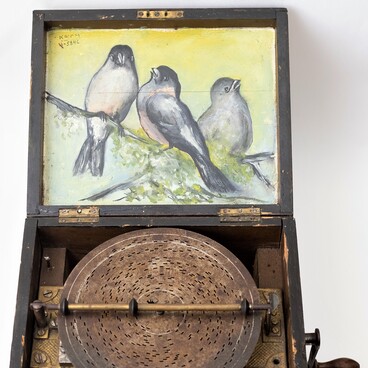The longcase clock was made in the late 19th — early 20th century. Presumably, it was acquired by the Olonets provincial administration since the clock was in one of the halls of the office building on Round Square. For more than a hundred years, provincial officials used this clock to check the time, and after the Bolshevik revolution, it remained in the same building, in the Central Committee of the Communist Party of the Bolsheviks of the Karelo-Finnish Soviet Socialist Republic. Now this building is transformed into the National Museum of the Republic of Karelia. The exhibit was donated to the museum collection in 1968.
The longcase clock was made by English watchmaker William Smith, whose company had been known in London since 1784. It is displayed in the section of the permanent exhibition “Urban People. Life of Petrozavodsk in the Late 19th — Early 20th Century”.
At the turn of the century, despite being the provincial center, Petrozavodsk remained a small town. However, wealthy townspeople sought to imitate the lifestyle of those living in the capital. They purchased elegant “Tonet” furniture, tables for card games, porcelain products, and longcase clocks for their apartments.
The clock case is made of wood. In the upper part, there are doors for adjusting the mechanism. Above the main dial, there is an additional one, which made it possible to count seconds. In a special clock window, the numbers were listed — they indicated the day of the month.
On the inner wall of the pendulum compartment is a piece of paper with a partially preserved inscription in Finnish, “… A reuna vain tan …” (“the edge is only here…”). A vertical line had been drawn between the letters R and E, probably denoting the line along which the pendulum was installed. Before launching, it had to be strictly upright. On the side of the case, there is an aluminum oval inventory tag with an embossed inscription “C.C.C.P.b K-733”. It was this very inscription that helped to come to a conclusion where this clock had been before it was donated to the museum. In the upper oval part of the dial, there is a disc with an arrow. It indicates the position of the clock, “Strike” (with striking) and “Silent” (without striking).
The longcase clock was made by English watchmaker William Smith, whose company had been known in London since 1784. It is displayed in the section of the permanent exhibition “Urban People. Life of Petrozavodsk in the Late 19th — Early 20th Century”.
At the turn of the century, despite being the provincial center, Petrozavodsk remained a small town. However, wealthy townspeople sought to imitate the lifestyle of those living in the capital. They purchased elegant “Tonet” furniture, tables for card games, porcelain products, and longcase clocks for their apartments.
The clock case is made of wood. In the upper part, there are doors for adjusting the mechanism. Above the main dial, there is an additional one, which made it possible to count seconds. In a special clock window, the numbers were listed — they indicated the day of the month.
On the inner wall of the pendulum compartment is a piece of paper with a partially preserved inscription in Finnish, “… A reuna vain tan …” (“the edge is only here…”). A vertical line had been drawn between the letters R and E, probably denoting the line along which the pendulum was installed. Before launching, it had to be strictly upright. On the side of the case, there is an aluminum oval inventory tag with an embossed inscription “C.C.C.P.b K-733”. It was this very inscription that helped to come to a conclusion where this clock had been before it was donated to the museum. In the upper oval part of the dial, there is a disc with an arrow. It indicates the position of the clock, “Strike” (with striking) and “Silent” (without striking).



